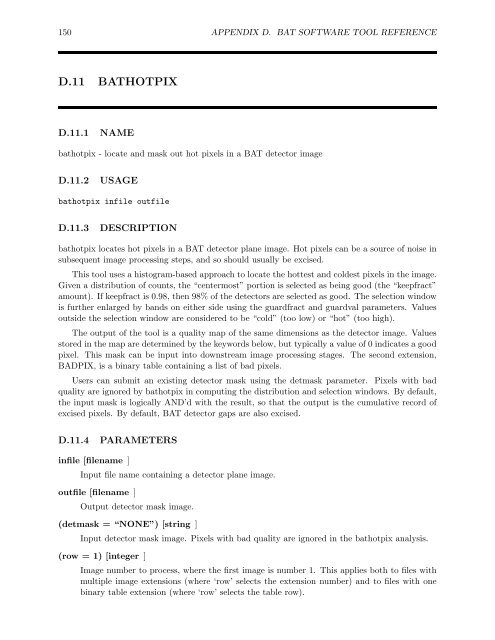The SWIFT BAT Software Guide Version 6.3 30 ... - HEASARC - Nasa
The SWIFT BAT Software Guide Version 6.3 30 ... - HEASARC - Nasa
The SWIFT BAT Software Guide Version 6.3 30 ... - HEASARC - Nasa
You also want an ePaper? Increase the reach of your titles
YUMPU automatically turns print PDFs into web optimized ePapers that Google loves.
150 APPENDIX D. <strong>BAT</strong> SOFTWARE TOOL REFERENCE<br />
D.11 <strong>BAT</strong>HOTPIX<br />
D.11.1 NAME<br />
bathotpix - locate and mask out hot pixels in a <strong>BAT</strong> detector image<br />
D.11.2 USAGE<br />
bathotpix infile outfile<br />
D.11.3 DESCRIPTION<br />
bathotpix locates hot pixels in a <strong>BAT</strong> detector plane image. Hot pixels can be a source of noise in<br />
subsequent image processing steps, and so should usually be excised.<br />
This tool uses a histogram-based approach to locate the hottest and coldest pixels in the image.<br />
Given a distribution of counts, the “centermost” portion is selected as being good (the “keepfract”<br />
amount). If keepfract is 0.98, then 98% of the detectors are selected as good. <strong>The</strong> selection window<br />
is further enlarged by bands on either side using the guardfract and guardval parameters. Values<br />
outside the selection window are considered to be “cold” (too low) or “hot” (too high).<br />
<strong>The</strong> output of the tool is a quality map of the same dimensions as the detector image. Values<br />
stored in the map are determined by the keywords below, but typically a value of 0 indicates a good<br />
pixel. This mask can be input into downstream image processing stages. <strong>The</strong> second extension,<br />
BADPIX, is a binary table containing a list of bad pixels.<br />
Users can submit an existing detector mask using the detmask parameter. Pixels with bad<br />
quality are ignored by bathotpix in computing the distribution and selection windows. By default,<br />
the input mask is logically AND’d with the result, so that the output is the cumulative record of<br />
excised pixels. By default, <strong>BAT</strong> detector gaps are also excised.<br />
D.11.4 PARAMETERS<br />
infile [filename ]<br />
Input file name containing a detector plane image.<br />
outfile [filename ]<br />
Output detector mask image.<br />
(detmask = “NONE”) [string ]<br />
Input detector mask image. Pixels with bad quality are ignored in the bathotpix analysis.<br />
(row = 1) [integer ]<br />
Image number to process, where the first image is number 1. This applies both to files with<br />
multiple image extensions (where ‘row’ selects the extension number) and to files with one<br />
binary table extension (where ‘row’ selects the table row).


